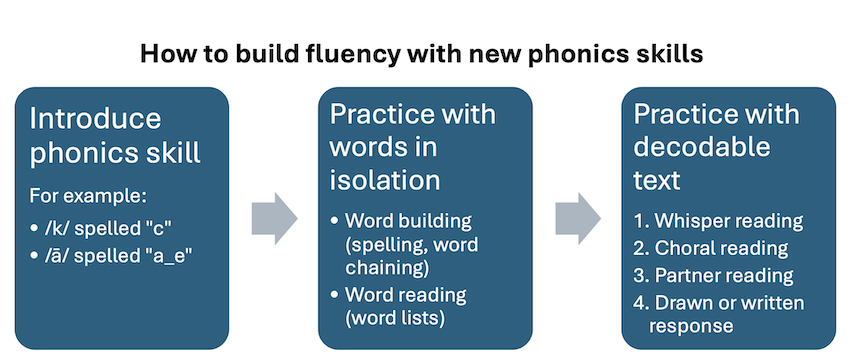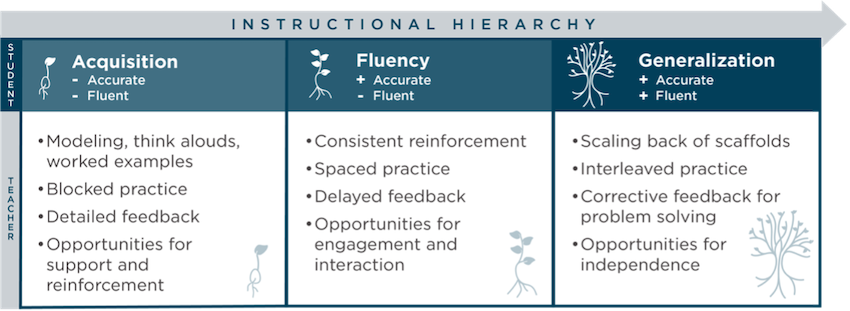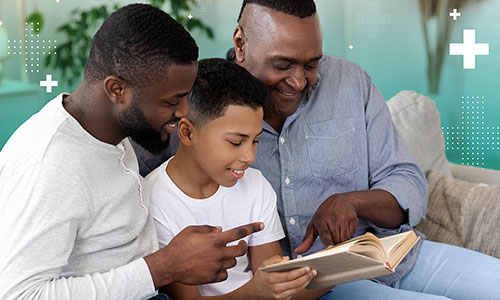
We all agree time spent practicing reading is crucial for young students, but which types of texts should we use, and for whom? When are decodable texts appropriate? And when should we provide students time with a wider variety of leveled texts? I’m here to help you understand the strengths and drawbacks of decodable and leveled texts—and when to use each.
What is a decodable text?
Although many texts are marketed as decodable texts, not all are created equal. “Decodability” is a term that refers to the number of words in a given text that students have been taught with corresponding phonics patterns and irregular words. If a text set is marketed as decodable text, you should ensure the order in which the set introduces phonics patterns and high-frequency words matches the scope and sequence of your phonics curriculum. If there is a mismatch, the decodable text set will not be decodable for your students.
For example, if a student has learned all short vowels and most common consonant sounds, the sentence “Sam lifts a big bag and fills it to the brim with grain” should be mostly decodable. However, the “ai” in “grain” and the words “a,” “to,” “the,” and “with” would not be, as they include phonics patterns that likely have not been taught, like the /oo/ in “to” and the /th/ in “with.” That’s because neither is a short vowel or common consonant sound. These high-frequency words and the phonics pattern “ai” spelling long A would need to be pre-taught to make this text 100% decodable. If none of these were pre-taught, this text would be only 61% decodable and most likely not as helpful for highly successful practice opportunity.
Why and when are decodable texts helpful for instruction?
Decodable texts are a perfect tool for reinforcing a taught phonics skill or pattern. They are necessary for fluency and application opportunities for students who have been introduced to a new phonics skill in whole-group or small-group instruction or during an intervention.
After you introduce a new phonics skill and provide practice opportunities to read and spell words in isolation, a decodable text is a logical and appropriate next step. Using a longer text with sentences or paragraphs that include a high proportion of practice opportunities with the new phonics skill can help your students build fluency with their new learning in the context of a connected text.

For example, if I am in the fall of kindergarten and have introduced the most common sounds for the letters S, A, D, P, I, N, and C, following my scope and sequence, my next lesson is /t/ spelled with the letter T. I will begin by practicing reading and spelling words like “at,” “sat,” “pat,” “pit,” and “tap.”
Students will stretch each word, write blanks for sounds, then fill in each with the letter that spells the sound. I will then have similar CVC words with /t/ and previous sounds they have learned, one at a time, on the board for students to sound out and blend together. Finally, I will provide my students with more practice, so they not only remember the sounds associated with the letters, but also become more fluent with those sounds in a short, aligned, and highly-decodable text. This may be a book with the sentences “Sam taps. Pat taps. Sam and Pat tap, tap, tap! Pat and Sam spin and spin!” and an illustration showing two friends tap dancing on a stage. Alternatively, I could ask students to read with partners after they read with me initially, and I could provide a blank space instead of the illustration for students to draw what they pictured while reading the text.
Note: Some programs teach consonant blends, such as “sp” or “bl,” as separate lessons. However, if students have learned both sounds in a blend, they can sound and blend together to form the spoken sounds /sp/ as in “spin” or /bl/ as in “blot.” Therefore, there is no need to waste precious instructional time on the many combinations of consonant blends in separate lessons. Consonant diagraphs, on the other hand, are two letters that combine to form a different consonant sound than they do separately, such as C and H in /ch/ or P and H in /ph/. These would need to be taught explicitly for students to understand the new, unexpected sound that is formed.
What is a leveled text?
Any trade book or text can be leveled. There are different leveling systems that use features of the text— such as word and sentence length, unique words, or other factors—to assign a “level.” Most of the time, as levels get higher in number or letter, texts are more challenging to both decode and comprehend.
Leveled texts aren’t inherently aligned to a particular phonics skill. Instead, they contain an amalgamation of phonics skills that are typically increasing in complexity as the levels increase. Some leveled texts that are part of a comprehensive literacy curriculum include certain focus words, such as high-frequency words and/or vocabulary words, that have been previously introduced in the whole group lesson to reinforce these concepts in connected text.
Why and when are leveled texts helpful?
Decodable and leveled texts are not the same. Leveled texts do not have the same purpose as decodable texts. They are not meant to practice a specific phonics skill. Instead, leveled texts can be useful to practice generalizing phonics skills already taught, high-frequency words previously introduced, and specific vocabulary from prior lessons.
Recent research indicates teachers using leveled texts should preview the text to ensure students have a base of knowledge of the phonics patterns included, meaning that they can read the text with about 93–97% accuracy to maximize student growth in reading fluency. Leveled readers should be chosen purposefully to align with the generalization stage of learning to read (so, after students have acquired a base level of knowledge of phonics included in the texts, as shown by reading with 93–97% accuracy). Consider also aligning with the content focus to help students generalize new vocabulary, high-frequency words, and/or knowledge across subjects and throughout the school day.
Please note that the information on leveled texts presented here does not apply to leveled texts that are predictable texts. Predictable, or repetitive, texts are typically found in the first few levels of most organized leveling systems, for example, Levels A–D in Guided Reading levels. These texts are not appropriate for students to learn to acquire new phonics skills or practice generalizing phonics patterns to new words. Because the texts at this stage have predictable and repetitive sentence stems, they can encourage students to use the picture, first letter(s), or context to guess at some words without looking closely at the letters within the word to confirm or change these predictions. Instead, these predictable texts may be more appropriate for shared reading, modeling rhyming during a poetry unit, or making inferences or predictions about the text. For more information, check out Spelfabet, a demonstration by Australian speech pathologist Alison Clarke.
A benefit to using leveled texts, rather than high-controlled decodable texts, is that students begin to learn to utilize their set for variability. That’s a term researchers use for a student’s ability to flex the pronunciation of a word they have decoded into one they recognize in their oral vocabulary. For example, if a student hasn’t yet learned that the letter A following a W typically spells the sound /ŏ/, they may first decode the word “wasp” in the sentence “The wasp stings the pig” as rhyming with the word “clasp.” However, if they know that a wasp is a stinging insect, they may use their set for variability to flex the pronunciation to the real word, “wasp.” Encouraging students to flex sounds during reading, and providing a range of texts to read, not just highly controlled decodable texts, can allow students to grow their phonics flexing muscles, thus jumpstarting their self-teaching abilities.
It is important to ensure students have a base of foundational phonics knowledge before asking them to generalize their skills to build fluency in leveled texts. However, without wide and varied text practice, students may not be exposed to enough word types to jumpstart this self-teaching and phonics flexing muscles. Be aware of that during your lesson planning.

The graphic above on instructional hierarchy was created by NWEA and adapted from Norris Haring and Marie Eaton’s “Systematic instructional procedures: An instructional hierarchy” in The Fourth R: Research in the Classroom. It illustrates different student learning needs and aligned teacher actions at each stage.
Decodable texts would fit well during the acquisition stage of learning and bring students into the fluency stage. Since the goal is to move through the generalization stage and into future literacy independence, leveled texts are an appropriate and necessary part of an early reader’s literacy learning journey.
Recommendations and next steps for teachers
If you’re a teacher, I encourage you to take inventory of your texts for teaching phonics skills. Ask yourself the following questions:
- What types of texts am I using to support this acquisition of introduced phonics skills and assist students in building fluency with those phonics skills?
- Do I have decodable texts for students to practice the specific phonics skills aligned with my phonics scope and sequence?
Next, take inventory of your library for students to practice reading a wide variety texts. Ask yourself:
- What types of texts am I using to support generalization and improve my students’ ability to flex sounds?
- Do I have other text types, such as leveled texts, that align to my students’ reading accuracy of 93–97%?
Finally, ensure students have ample opportunity to read a variety of texts every day. Ask yourself:
- At what point today did students read texts with teacher guidance to practice and receive feedback on new skills or challenging texts?
- At what point today did students read texts with peer feedback to build fluency and understanding?
- At what point today did students read texts independently to extend fluency practice on previously introduced texts or practice their skills?
Recommendations and next steps for leaders
If you’re a school leader, there’s a lot you can do to support your reading teachers in using decodable and leveled texts appropriately.
First, ensure your teachers have the following types of texts for optimizing student literacy success:
- Decodable texts that align with their adopted phonics scope and sequence
- Leveled texts that align with their content topics or ELA high-frequency words and new vocabulary
It’s important that you ensure predictable texts are not part of early literacy word recognition instruction.
Next, I encourage you to check out our evidence-aligned professional learning offerings on Early Word Recognition, Advanced Word Recognition, and Building Fluent Readers for more extended learning opportunities for your entire school staff.






